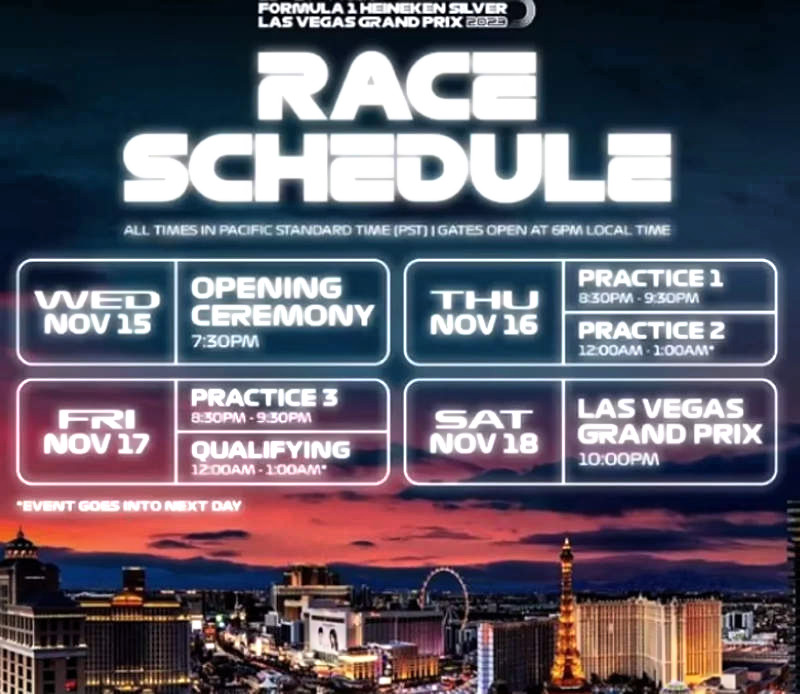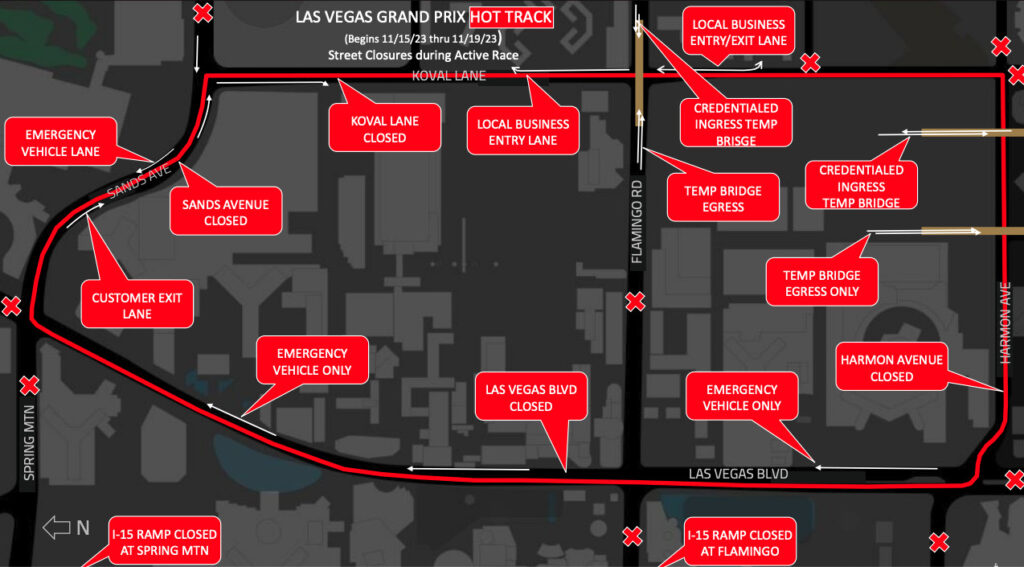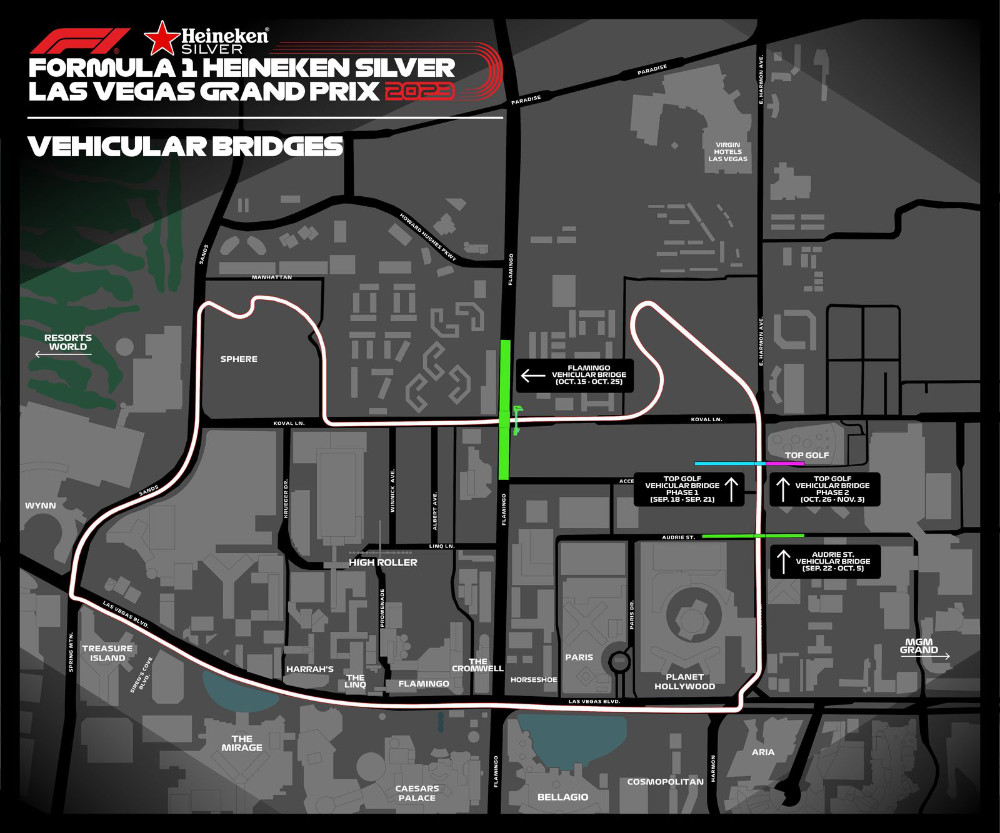Imagine some of the world’s fastest cars racing down the Las Vegas Strip at speeds over 200 mph. Now imagine you’ve paid for your ticket to the grandstands and your hotel room for a three-day event that cost you over $10,000 dollars. With a large-scale event such as a Formula One race comes some challenges that have many locals wondering how all this will play out for the next 10 years as the F1 race will be on the main strip of Las Vegas.
This is exactly where we are right now with all the preparation of road construction, barriers, grandstand seating, and blocking of vital traffic to hotels and other businesses surrounding the circuit along the way. Construction started at the beginning of summer for the race track that spans the central part of the Las Vegas Strip. The bottle-necked traffic was horrible for just about anyone coming and going into the central area of construction.
The back end of the track was the worst as city crews had to bury all utility lines that hindered views from the grandstands that were going up at the same time. Not to mention the traffic bridges had to be assembled to divert traffic up over the race track as well as pedestrian bridges that were put up around Harmon and Koval areas.
Table of Contents
The Formula One Spectacle in Las Vegas
Formula One (F1) race is a high-profile motorsport event that features some of the fastest and most technologically advanced racing cars in the world.
- History: Formula One is the highest class of single-seater auto racing. It has a rich history dating back to the mid-20th century, with the first official Formula One World Championship held in 1950.
- Championship: Formula One races are part of a season-long championship. Typically, the championship consists of around 20 races held in various countries, with the goal of crowning a World Drivers’ Champion and a World Constructors’ Champion at the end of the season.
- Teams and Drivers: F1 features teams, known as constructors, and drivers. Each team designs and builds its own car, with the goal of winning both individual races and the championship. Prominent F1 teams include Ferrari, Mercedes, Red Bull Racing, and McLaren.
- Circuits: F1 races take place on a variety of circuits, ranging from traditional racetracks to street circuits in urban areas. Iconic circuits include the Circuit de Monaco, Silverstone Circuit, and Circuit of the Americas.
- Practice Sessions: Before the race, there are several practice sessions where drivers and teams fine-tune their cars and strategies.
- Qualifying: Qualifying sessions determine the starting grid for the race. Drivers aim for the fastest lap times to secure a favorable position.
- Race Day: The race itself is typically held on a Sunday. It consists of a specified number of laps, usually ranging from 53 to 78, depending on the circuit’s length. The Las Vegas Circuit will be 50 laps with a 3.5-mile track. The goal is to complete these laps as quickly as possible.
- Pit Stops: During the race, teams make pit stops to change tires, refuel, and make adjustments to the car. Pit stops can be a crucial factor in a race’s outcome.
- Strategy: Teams and drivers must carefully plan their race strategy, considering factors like tire management, weather conditions, and the performance of their competitors.
- Winning: The driver who crosses the finish line first is the race winner. Points are awarded based on the finishing order, contributing to the season-long championship.
The Las Vegas Allure:
Racing on the Las Vegas Strip will be quite the thrill for just about any race enthusiast. Especially with a 10 p.m. race that will be lit up with the neon backdrop of the Las Vegas casinos and hotels. This will be the cream of the crop of racing and will be marked as one of the most thrilling races seen around the world.

Global Fan Base and Broadcast:
- Formula One has a massive global fan base, with millions of viewers tuning in to watch races. F1 races are broadcast in over 200 countries, making it one of the most-watched motorsport events worldwide.
- In recent years, digital platforms and streaming services have made it easier for fans to access F1 content and follow their favorite teams and drivers.
Traffic Chaos on the Las Vegas Strip
Do we even have to mention the chaos that will ensue for fans and visitors? Let’s break it down.
Keep in mind that the traffic flow will change depending on what day it is and what time it is.
Here are the three separate traffic management plans that will be in place: cold track, warm track, and hot track.
Hot track procedures will be put in place from Nov. 15 through Nov. 18 from 5 p.m. to 5 a.m. each day. That includes closures at the I-15 ramp at Spring Mountain, and the I-15 ramp at Flamingo, Sands Avenue, Koval Lane, and Harmon Avenue.



How will drivers know where to go?
According to race officials, there will be about 180 flaggers located around the circuit to help drivers go where they need to go. There will also be message boards that are being installed, starting on Saturday.
More info on traffic and FAQ at Formula One Website
Uber/Lyft and get dropped off in front of my zone?
There will be designated rideshare pick-up and drop-off locations at Virgin Hotels Las Vegas and the Hughes Center.
“The blue message boards have to be up at least 72 hours before the event to tell drivers and vehicles what to expect,” said Terry Miller from Miller Project Management. “The red indicates a hard stop meaning drivers have to turn right or left and can’t come any further into the circuit. Green is for Uber, Lyft, and taxis. The light aqua color is really the credentialed areas.”
What if I’m staying at a resort in or near the circuit?
According to race officials have added several drop-off and pick-up locations that can be accessed while hot track closures are in place.
Hotel guests can get picked up at the airport and get dropped off at a remote parking lot. Then, they get on a shuttle that comes over the Flamingo Bridge and does a loop around those properties.
However, if you are taking a taxi or rideshare there will be surge pricing for this event. That’s all I have to say about that. Be aware of the pickup zones that each hotel has for taxis and rideshare.
Local Businesses’ Struggles
Most of the off-the-strip businesses will be affected by the road closures and the race itself. There is no way to mitigate their loss. This is the downside of this race. It can cause the surrounding businesses to close for that weekend and make no revenue at all. This is unacceptable for the fact that most of these businesses rely on consistent traffic, especially from a weekend rush. Now they will have to turn off the lights til the weekend is over.
This is why most local Las Vegas residents are not in favor of the Formula One race around the Las Vegas Strip. The amount of money spent so far is an estimated $400 million dollars for all the road construction, grandstand assembly, and infrastructure construction they could have taken that $400 million off the strip and built a custom-made track North next to The Las Vegas Raceway which has plenty of room for just an event such as this. This would alleviate most of the disruptions that Formula One has been at since the beginning of the summer of 2023.
Economic Impact Assessment
The only economic impact that this will bring is that Las Vegas will be on television for this race so that the world can see that the only people who will benefit are the casinos, restaurants, and shops that are in the circuit. Everyone else will have to fend for themselves as transportation workers will most likely feel the spare change from the bottom of the barrel as they waste most of their day waiting in heavy traffic transporting the very elite to their highly esteemed event. Will hotdog vendors be allowed to vend at the F1? Will they make a comeback?